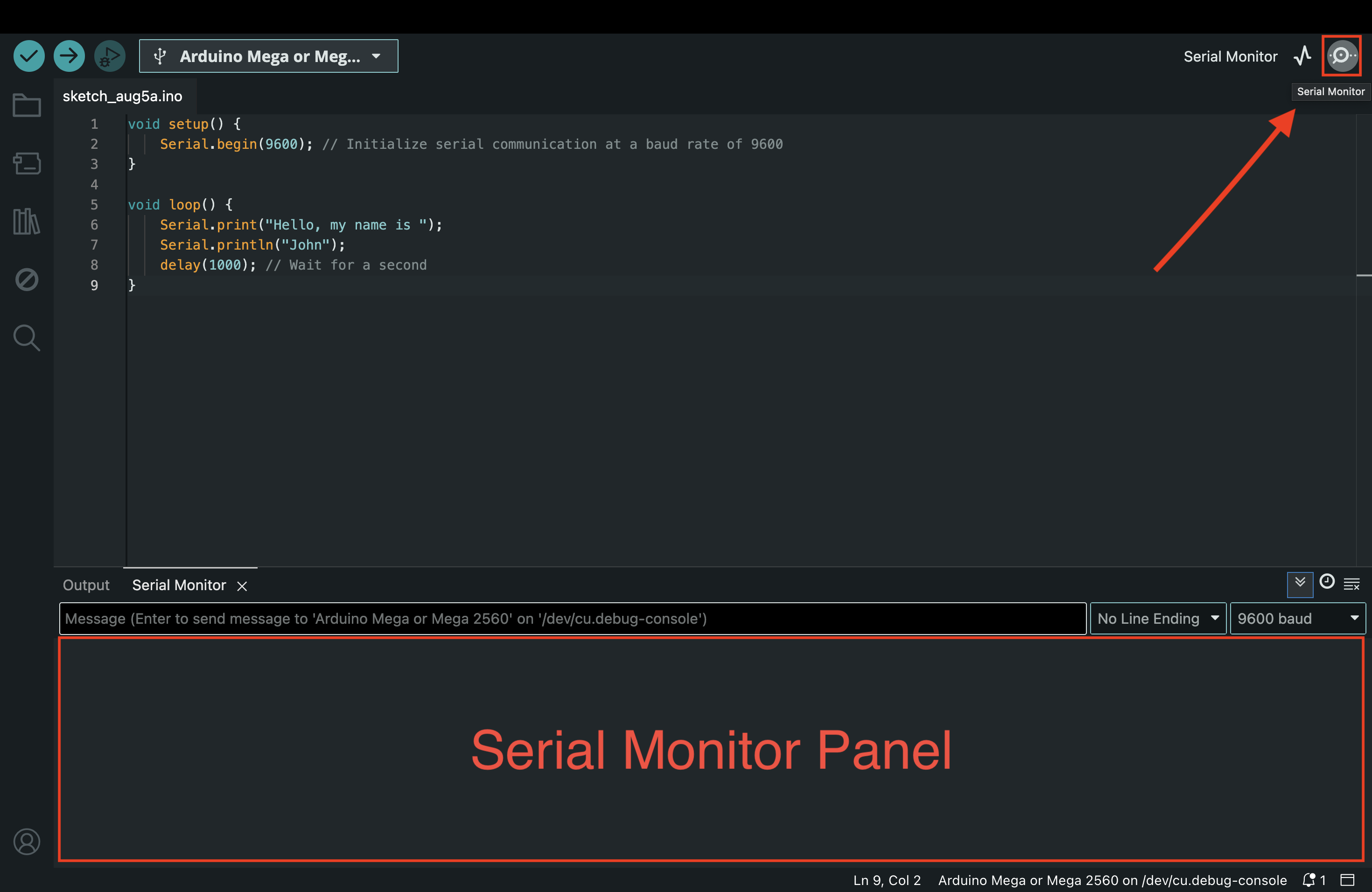The Serial Monitor
The serial monitor is a tool within the Arduino IDE which we can use to communicate to and from the Arduino board. The serial monitor is especially useful when debugging and testing out different components to ensure they are functioning as expected.
Printing data to the serial monitor
To print data to the serial monitor, we need to first begin serial communication at a specified baud rate. Some common baud rates we can initialize serial communication with include 9600 and 115200.
We can then print data to the serial monitor using Serial.print() or Serial.println(). For instance:
void setup() {
Serial.begin(9600); // Initialize serial communication at a baud rate of 9600
}
void loop() {
Serial.print("Hello, my name is ");
Serial.println("John");
delay(1000); // Wait for a second
}
Serial.begin()- sets the baud rate for serial transmission.Serial.print()- prints data to the serial monitor without adding a new line at the end.Serial.println()- prints data to the serial monitor and then moves to the next line.

We can open our serial monitor by clicking the magnifying glass icon in the top-right corner of the Arduino IDE. This has been highlighted in the image above. Make sure that the baud rate in the serial monitor panel matches the one you have initialized in your code.
- Problem
- Solution
Write a simple Arduino program by creating an integer named count that starts at 0, prints it to the serial monitor, and increases the count by 1 each iteration.
Don't forget to use a delay to make sure it doesn't print too fast!
int count = 0;
void setup() {
Serial.begin(9600);
}
void loop() {
Serial.println(count);
count = count + 1;
delay(500); // wait for half a second
}
Inputting data from the serial monitor
Now that we have learnt how to output data to the serial monitor, we should also learn how to input data from the serial monitor. To input from the serial monitor, we follow a three step process:
- Prompt the user for input. We can use
Serial.print()orSerial.println()to do so.
Serial.println("Enter a number: ");
- Wait for input using a
whileloop and theSerial.available()function. TheSerial.available()function returns the number of bytes available for reading from the serial port.
while (Serial.available() == 0) {
// Wait for input
}
Effectively, this helps to pause execution of the program until data is recieved from the user.
- Read and store input using functions like
Serial.readString(),Serial.parseInt()andSerial.parseFloat, depending on the input data type. We can then store the read data in a variable. For example:
int myInput = Serial.parseInt();
Inputting a username and greeting the user.
void setup() {
Serial.begin(9600);
}
void loop() {
Serial.println("What is your name?"); // prompt
// Wait until the user types something
while (Serial.available() == 0) {
// Do nothing
}
String userName = Serial.readString();
Serial.print("Hello, ");
Serial.print(userName);
Serial.println("!");
delay(2000);
}
Assignment
- Write a program to input how many times an LED should blink, and how fast the LED should blink using the serial monitor. Use this data to control how many times, and how fast an LED blinks. Refer back to a previous lesson if you're unsure on how to build a simple LED circuit.
Next Steps
This section includes links to help you dive deeper into the topics from this lesson. It's optional, so don't worry if you choose to skip it.
- Check out this basic intro to the serial monitor.